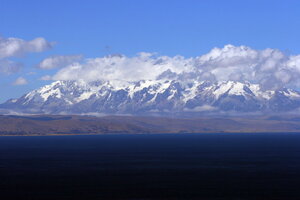Peru investigates death of 10,000 Titicaca water frogs
Many locals believe that the die-off is the results of sewage runoff from the town of Juliaca. Authorities observed sludge and solid waste during an investigation.

View of the snow-capped Cordillera Real of the Bolivian Andes and Lake Titicaca as seen from Isla del Sol. The rare Titicaca water frog is facing threats from sewage, invasive trout, and being overharvested for a health elixir.
Susannah H. Snowden/File
Scientists in Peru are currently investigating why thousands of frogs are dying along the Coata River in Peru, which empties into Lake Titicaca.
The population of the critically endangered Titicaca water frog is estimated to have already declined nearly 80 percent in 15 years as a result of over-harvesting, the arrival of an invasive species of trout that eats the tadpoles, and habitat destruction. However, the cause of this recent large-scale die-off has yet to be determined, and the Peruvian National Forest and Wildlife Service (SERFOR) is launching an investigation to find answers.
"Based on local residents' statements and samples taken in the days after the incident, it is believed that more than 10,000 frogs were affected over about 50 kilometers (30 miles)," the agency said in a statement.
The species, which lives only in Lake Titicaca and its tributaries, can weigh up to two pounds on account of its characteristic thick layers of folded skin. The skin is actually an evolutionary adaptation. In order to breathe at it its high altitude habitat – at 12,507 feet, Lake Titicaca is the world's highest navigable lake – the frogs breathe through their skin folds and have a high red blood cell count, which gives them a high oxygen capacity.
Frogs have been dying along the Coata River, from the famed Incan Cacachi rope bridge, past the city of Juliaca, and into Lake Titicaca. Many locals believe that the die-off is the result of sewage runoff from Juliaca, and authorities observed sludge and solid waste during an investigation, CNN reports.
The die-off was first reported to SERFOR by Maruja Inquilla Sucasaca, an activist with the Committee to Combat Pollution of the Coata River. When Ms. Inquilla and other activists felt that the issue was not getting enough attention, they brought 100 of the dead frogs to the central square of Puno, the regional capital city that sits on the shore of Lake Titicaca.
"I've had to bring them the dead frogs. The authorities don't realize how we're living. They have no idea how major the pollution is. The situation is maddening," Inquilla told the AFP. "Why is the state so apathetic? We need a sewage treatment plant now."
Sewage is only the latest potential threat to the Titicaca water frog. An invasive species of trout eats the frogs' tadpoles. The frogs have also become a local delicacy, thought to be a remedy for various aliments. Frog juice, jugo de rana, combines a blended frog, the leaves of the maca plant, water, and honey. Various investigations show that between 50 and 150 frogs are harvested every day for this practice.
Peruvian authorities are currently testing water samples in order to determine the cause of this sudden die-off with the help of frog specialists at the Denver Zoo.

